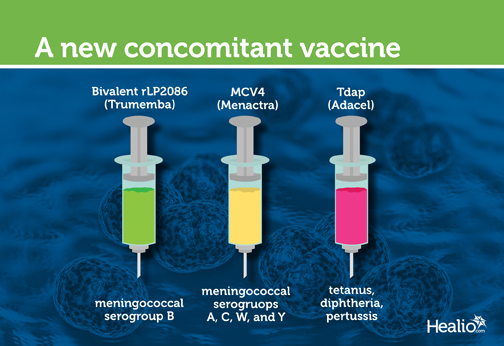Concomitant administration of Trumenba with Menactra, Adacel passes noninferiority trial
A phase 2 noninferiority trial suggested that concomitant administration of Trumenba with Menactra and Adacel induced the same immune response as Trumenba alone and Menactra and Adacel together.
“Concomitant administration is an important means of simplifying vaccination schedules and improving adherence,” Derek Muse, MD, at Jean Brown Research in Salt Lake City, and colleagues wrote in The Pediatric Infectious Disease Journal. “In clinical practice, the ability to administer bivalent rLP2086 [Trumenba, Pfizer] with other vaccines recommended in adolescents will help achieve higher vaccine acceptance, and therefore decrease devastating cases of [meningococcal serogroup B] disease.”

Derek Muse
For children aged 11 or 12 years, the Advisory Committee on Immunization Practices (ACIP) recommends the concomitant administration of Menactra (MCV4, Sanofi Pasteur), which protects against meningococcus serogroups A, C, Y, and W-135, and a booster dose of Adacel (Tdap, Sanofi Pasteur), the researchers wrote. In practice, many adolescents receive both vaccines at age 10 years due to school entry requirements. Bivalent rLP2086 and Bexsero (4CMenB, Novartis) are the only two meningococcal serogroup B vaccines licensed in the United States.
To examine if a vaccine combining both meningococcal vaccines with Tdap would induce the same immune response as these vaccines alone, the researchers performed a randomized, active-controlled, observer-blinded noninferiority trial of 2,648 patients aged 10 to 13 years. One month after each patient was vaccinated, the researchers assessed bivalent rLP2086 response with human complement serum bactericidal assays (hSBAs) using two meningococcal serogroup B test strains that expressed vaccine-heterologous factor H binding protein variants. In addition, they assessed MCV4 with SBAs using rabbit complement and evaluated Tdap with multiplexed Luminex assays.
The patients’ immune response of the concomitant vaccine containing bivalent rLP2086, MCV4 and Tdap (n = 888) was noninferior to MCV4 and Tdap administration (n = 878) and to the vaccine containing only bivalent rLP2086 (n = 882). For the concomitant vaccine, the investigators detected seroprotective hSBA titers in 62.3% to 68% of patients after the second dose and between 87.5% and 90% of patients after the third dose. In addition, they found between 56.3% and 64.3% of patients experienced at least a fourfold rise of hSBA titers from baseline after the second dose and between 84% and 85.7% of patients after the third dose. A similar hSBA response was observed in patients assigned rLP2086 alone, but concomitant administration did not increase reactogenicity. One patient reported a fever that resolved within 1 day, while no other adverse effects were identified during the study.

The hSBA response titers of rLP2086 were consistent with those reported in its initial licensure study, the researchers wrote. In addition, these data support the ACIP recommendation that serogroup B vaccines can be administered concomitantly with ACWY vaccines.
“The results of this study indicate that bivalent rLP2086, MCV4, and Tdap can be coadministered safely to adolescents while maintaining the immune response to these vaccines,” Muse and colleagues wrote. “The recently licensed bivalent rLP2086 has the potential to substantially reduce the occurrence of outbreaks and the incidence of disease if recommended and successfully implemented into the adolescent vaccine schedule.” – by Will Offit
Disclosure: Muse reports receiving research support from Pfizer for the completion of this study. Please see the full study for a list of all other authors’ relevant financial disclosures.
